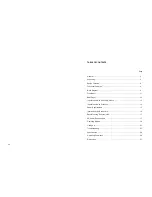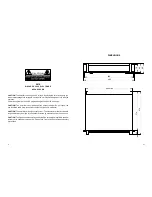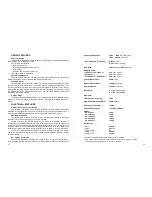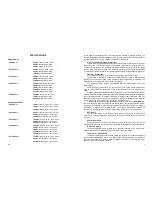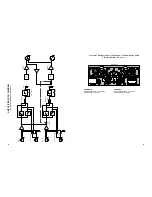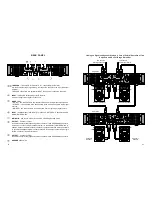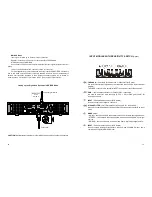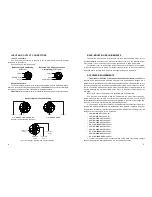
4
29
DESIGN FEATURES
Physical Design
The amplifier is enclosed in a metal (steel) case of 2U height. The amplifier is designed
to be installed into a standard 19" rack.
The amplifier incorporates:
–
power supply source;
–
two similar amplifying monoblock units;
–
input module;
–
indication and input level control unit.
The input module is replaceable.
Power Supply Source
Common for both channels. The power supply source consists of a soft-start unit, a
toroidal transformer, ac/dc converters and a filter capacitor PCB.
Cooling System
Fans are used to cool the output stage. The cooling system is independent for each
channel. The air flows backwards. The cooling intensity changes progressively in the
process of operation. On power-on and when the output power is fairly low, the fan runs at
a low speed thus minimizing the acoustic noise. As the output power goes up and so rises
the temperature of the output stage heat sinks, the fan starts blowing harder, thus
intensifying the cooling process.
Output Stage
The output stage is designed with the use of complementary pairs of TOSHIBA bipolar
transistors. The output stage is based on Class H technology with double-level power
supply.
FUNCTIONAL FEATURES
Output Short-Circuit Protection
The amplifier is provided with individual protection for each channel and global
protection in the bridge mode. The protective system does not switch the amplifier off, so it
resumes its unattended operation after the short-circuiting conditions are gone.
Overload Protection
The double-stage overload protection system provides both reliable output stage
protection and perfect sonic quality even under overload.
In case of a short-time overload lasting up to 3 msec., (e.g. overload caused by a
sudden drop of total load impedance), only the output stage current protection goes active
limiting the current running through the output transistors at the safe level. In this case the
protection system does not preclude the amplifier from delivering, for a short while, a full
output power (without any output voltage reduction) even to loads of very low impedance.
In case of a more continuous overload, the protection system activates the built-in
Clip-limiter, which reduces the level of the input signal and eliminates the distortion, caused
by hard clipping.
DC Output Protection
The amplifier schematics precludes any clicks or noise occurring during the power-
on/off transition processes without utilizing any relay commonly used for connecting the
Frequency Response:
20Hz ... 20kHz
(
0.2dB, Pnom.)
10Hz ... 60kHz
(1dB, 1W)
Total Harmonic Distortion:
0.003%
(1kHz)
0.02 %
(20Hz ... 20kHz)
Slew Rate:
40V/µs
(channel)
, 80V/µs
(bridge)
Damping Factor:
–
V4-900
MkIII
, V4-1200
MkIII
400
(1kHz, 8Ohm)
–
V4-1800
MkIII
400
(1kHz, 8Ohm)
–
V2-2400
MkIII
, V4-2400
MkIII
600
(1kHz, 8Ohm)
Channel Separation:
60dB
(1kHz)
Signal-to-Noise Ratio:
100dB
(unweighted)
Input Impedance:
10 kOhm
(balanced)
Sensitivity:
0.775V
(standart model)
0.775V, 1.4V, 32dB
( * )
High-pass
Filter Cutoff Frequency**:
35Hz
High-Pass Filter Slope Rate**:
24dB/octave
Crossover Frequency***:
125Hz
Power Requirements:
~230V AC, 50/60Hz
Weight:
–
V4-900
MkIII
14kg
–
V4-1200
MkIII
15kg
–
V4-1800
MkIII
16kg
–
V2-2400
MkIII
18.5kg
–
V4-2400
MkIII
18.5kg
Dimensions:
–
width
482 mm
–
height
96mm
–
height in rack
2U
–
depth
414 mm
–
depth in rack
374mm
* Only when an input module with a sensitivity switch is installed.
** Only when an input module with a sensitivity switch or with a crossover is installed.
*** Only when an input module with a crossover is installed.



